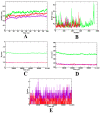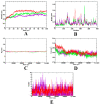Antidiabetic Activity of Potential Probiotics Limosilactobacillus spp., Levilactobacillus spp., and Lacticaseibacillus spp. Isolated from Fermented Sugarcane Juice: A Comprehensive In Vitro and In Silico Study
- PMID: 37111101
- PMCID: PMC10144524
- DOI: 10.3390/nu15081882
Antidiabetic Activity of Potential Probiotics Limosilactobacillus spp., Levilactobacillus spp., and Lacticaseibacillus spp. Isolated from Fermented Sugarcane Juice: A Comprehensive In Vitro and In Silico Study
Abstract
Probiotics are regarded as a potential source of functional foods for improving the microbiota in human gut. When consumed, these bacteria can control the metabolism of biomolecules, which has numerous positive effects on health. Our objective was to identify a probiotic putative Lactobacillus spp. from fermented sugarcane juice that can prevent α-glucosidase and α-amylase from hydrolyzing carbohydrates. Isolates from fermented sugarcane juice were subjected to biochemical, molecular characterization (16S rRNA) and assessed for probiotic traits. Cell-free supernatant (CS) and extract (CE) and also intact cells (IC) were examined for the inhibitory effect on α-glucosidase and α-amylase. CS of the strain showed the highest inhibition and was subjected to a liquid chromatography-mass spectrometry (LCMS) analysis to determine the organic acid profile. The in silico approach was employed to assess organic acid stability and comprehend enzyme inhibitors' impact. Nine isolates were retained for further investigation based on the preliminary biochemical evaluation. Limosilactobacillus spp., Levilactobacillus spp., and Lacticaseibacillus spp. were identified based on similarity > 95% in homology search (NCBI database). The strains had a higher survival rate (>98%) than gastric and intestinal fluids, also a high capacity for adhesion (hydrophobicity > 56%; aggregation > 80%; HT-29 cells > 54%; buccal epithelial cells > 54%). The hemolytic assay indicated that the isolates could be considered safe. The isolates' derivatives inhibited enzymes to varying degrees, with α-glucosidase inhibition ranging from 21 to 85% and α-amylase inhibition from 18 to 75%, respectively. The CS of RAMULAB54 was profiled for organic acid that showed the abundance of hydroxycitric acid, citric acid, and lactic acid indicating their role in the observed inhibitory effects. The in silico approach has led us to understand that hydroxycitric acid has the ability to inhibit both the enzymes (α-glucosidase and α-amylase) effectively. Inhibiting these enzymes helps moderate postprandial hyperglycemia and regulates blood glucose levels. Due to their promising antidiabetic potential, these isolates can be used to enhance intestinal health.
Keywords: lactic acid bacteria; probiotic; sugarcane; α-amylase; α-glucosidase.
Conflict of interest statement
The authors declare no conflict of interest.
Figures











Similar articles
-
Isolation and characterization of lactic acid bacteria with potential probiotic activity and further investigation of their activity by α-amylase and α-glucosidase inhibitions of fermented batters.Front Microbiol. 2023 Jan 23;13:1042263. doi: 10.3389/fmicb.2022.1042263. eCollection 2022. Front Microbiol. 2023. PMID: 36756202 Free PMC article.
-
Probiotic Potential Lacticaseibacillus casei and Limosilactobacillus fermentum Strains Isolated from Dosa Batter Inhibit α-Glucosidase and α-Amylase Enzymes.Microorganisms. 2022 Jun 11;10(6):1195. doi: 10.3390/microorganisms10061195. Microorganisms. 2022. PMID: 35744713 Free PMC article.
-
Screening for potential novel probiotic Levilactobacillus brevis RAMULAB52 with antihyperglycemic property from fermented Carica papaya L.Front Microbiol. 2023 Jun 20;14:1168102. doi: 10.3389/fmicb.2023.1168102. eCollection 2023. Front Microbiol. 2023. PMID: 37408641 Free PMC article.
-
Flavonoids as potential agents in the management of type 2 diabetes through the modulation of α-amylase and α-glucosidase activity: a review.Crit Rev Food Sci Nutr. 2022;62(12):3137-3207. doi: 10.1080/10408398.2020.1862755. Epub 2021 Jan 11. Crit Rev Food Sci Nutr. 2022. PMID: 33427491 Review.
-
Lacticaseibacillus paracasei LB12, a Potential Probiotic Isolated from Traditional Iranian Fermented Milk (Doogh).Curr Microbiol. 2023 Sep 2;80(10):333. doi: 10.1007/s00284-023-03376-z. Curr Microbiol. 2023. PMID: 37658854 Review.
Cited by
-
Hypoglycemic, Antioxidant Activities, and Probiotic Characteristics of Lacticaseibacillus rhamnosus LBUX2302 Isolated from Stool Samples of Neonates.Life (Basel). 2025 May 18;15(5):804. doi: 10.3390/life15050804. Life (Basel). 2025. PMID: 40430230 Free PMC article.
-
Sauerkraut-derived LAB strains as potential probiotic candidates for modulating carbohydrate digestion attributing bacterial organic acid profiling to antidiabetic activity.Food Sci Nutr. 2024 Oct 23;12(11):9682-9701. doi: 10.1002/fsn3.4444. eCollection 2024 Nov. Food Sci Nutr. 2024. PMID: 39620004 Free PMC article.
-
Novel food isolates with striking α-glucosidase inhibitory activity and probiotic potential for an antidiabetic role.J Food Sci Technol. 2024 Jul;61(7):1283-1294. doi: 10.1007/s13197-023-05897-8. Epub 2023 Dec 11. J Food Sci Technol. 2024. PMID: 38910925 Free PMC article.
-
Engineering Probiotics for Diabetes Management: Advances, Challenges, and Future Directions in Translational Microbiology.Int J Nanomedicine. 2024 Oct 28;19:10917-10940. doi: 10.2147/IJN.S492651. eCollection 2024. Int J Nanomedicine. 2024. PMID: 39493275 Free PMC article. Review.
-
Cell-free supernatant of Levilactobacillus brevis (RAMULAB51) from coconut inflorescence sap (Neera) enhances glucose uptake and PPAR-γ in 3T3-L1 adipocytes and inhibits α-glucosidase and α-amylase.Front Microbiol. 2024 Dec 23;15:1497023. doi: 10.3389/fmicb.2024.1497023. eCollection 2024. Front Microbiol. 2024. PMID: 39764448 Free PMC article.
References
-
- Ramu R., Shirahatti P.S., Zameer F., Ranganatha L.V., Nagendra Prasad M.N. Inhibitory Effect of Banana (Musa Sp. Var. Nanjangud Rasa Bale) Flower Extract and Its Constituents Umbelliferone and Lupeol on α-Glucosidase, Aldose Reductase and Glycation at Multiple Stages. S. Afr. J. Bot. 2014;95:54–63. doi: 10.1016/j.sajb.2014.08.001. - DOI
-
- Sarwar N., Gao P., Kondapally Seshasai S.R., Gobin R., Kaptoge S., di Angelantonio E., Ingelsson E., Lawlor D.A., Selvin E., Stampfer M., et al. Diabetes Mellitus, Fasting Blood Glucose Concentration, and Risk of Vascular Disease: A Collaborative Meta-Analysis of 102 Prospective Studies. Lancet. 2010;375:2215–2222. doi: 10.1016/S0140-6736(10)60484-9. - DOI - PMC - PubMed
MeSH terms
Substances
LinkOut - more resources
Full Text Sources
Miscellaneous

